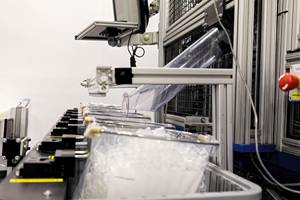Materials: Modified PEBA and TPU Medical Compounds Resist Hydrolytic Degradation
Clariant’s new Mevopur medical compounds allow for high loadings of radiopaque metals.
In collaboration with a leading medical device manufacturer, Clariant Plastics & Coatings Healthcare Polymer Solutions, Charlotte, N.C., has completed development and testing of new thermoplastic compounds specially formulated to resist degradation caused by exposure to high humidity and temperature. The new technology is especially crucial in resins that incorporate high loadings of radiopaque metals because these fillers are known to exacerbate the degradation effect.
Marketed under the Mevopur brand of Clariant’s medical-grade materials, the new modified PEBA (polyether block amide) and TPU compounds, showcased at MD&M West 2020, are expected to be especially useful in applications like medical catheters.
Catheters are typically made of relatively soft, flexible materials like PEBA or certain TPUs. These materials commonly contain metallic fillers like tungsten or tungsten carbide so that doctors and technicians can see the exact position of the catheter under X-ray fluoroscopy. But, according to global head of marketing & business development Steve Duckworth, when exposed to heat and humidity over time, the polymer chains responsible for developing critical physical and mechanical properties become broken. In turn, the functionality of the device – and patient safety – may be seriously compromised. These hydrolysis effects can occur even with very small quantities of moisture trapped on the surface of the polymer, filler ingredients, or on the pellets of the compound, he notes.

Clariant’s new technology is a combination of proprietary processing techniques and additives that serve to make the polymer resistant to hydrolytic degradation. Accelerated aging tests conducted on both extruded tubing and injection-molded test samples show significant improvement in resistance compared to unmodified materials.
One of the early indications of chain breakage (scission) is an increased melt flow index (MFI), or reduction in viscosity, as the chains become shorter. The MFI of a standard 74% tungsten-filled PEBA Shore 35D compound was compared to an otherwise equivalent Mevopur modified compound over a 26-week period. In just the first few weeks, there was a significant increase in melt fluidity of the standard resin, and after the fourth week, the MFI was no longer measurable. In contrast, the Mevopur compound showed almost no change. The observed difference was even greater during testing when tungsten-carbide-filled materials were used.
When the same materials were molded into tensile-test bars and measured for tensile strength and elongation, the unmodified samples saw reduction of 20 to 25% in these critical properties over the 26-week test period, while the Mevopur samples remained near 100%. In further mechanical-properties testing, the difference in results for tungsten-carbide-filled materials was much more pronounced.
“The final quality and reliability of catheter components relies on the stability and predictability of polymer material properties over a wide range of conditions. Our testing on the new Mevopur radiopaque compounds shows the risk of polymer degradation from hydrolysis can be significantly reduced so predictability can be restored. This also demonstrates the importance of long-term collaboration between the device manufacturer and a materials supplier like Clariant,” says Duckworth..
Clariant manufactures Mevopur concentrates and compounds at its EN:ISO13485-2016 certified facility in Lewiston Maine, part of a global network of ISO13485 facilities that also includes sites in Europe and Asia. The dedicated expertise of the Clariant’s Healthcare Polymer Solutions team has developed products from PE to PEEK using USP Class VI, ISO10993 pre-tested ingredients. The Mevopur portfolio has included PEBA, TPU, nylon 12, along with various radiopaque fillers, for more than 10 years. Fluoropolymers were recently added to the portfolio.
Related Content
Artificial Intelligence Enables Smarter Sourcing
Westfall Technik has adopted Arkestro’s predictive procurement software to wring savings and more reliable deliveries from a historically challenging supply chain.
Read MoreNew Cap for Child-Resistant Pill Bottles Is Senior-Friendly & Saves Resin
Exclusive lightweight cap design can be removed simply pushing down on the center. No gripping or twisting needed.
Read MoreUse Cavity Pressure Measurement to Simplify GMP-Compliant Medical Molding
Cavity-pressure monitoring describes precisely what’s taking place inside the mold, providing a transparent view of the conditions under which a part is created and ensuring conformance with GMP and ISO 13485 in medical injection molding.
Read MoreAs Currier Grows in Medical Consumables, Blow Molding Is Its ‘Foot in the Door’
Currier Plastics has added substantial capacity recently in both injection and blow molding for medical/pharmaceutical products, including several machines to occupy a new, large clean room.
Read MoreRead Next
Advanced Recycling: Beyond Pyrolysis
Consumer-product brand owners increasingly see advanced chemical recycling as a necessary complement to mechanical recycling if they are to meet ambitious goals for a circular economy in the next decade. Dozens of technology providers are developing new technologies to overcome the limitations of existing pyrolysis methods and to commercialize various alternative approaches to chemical recycling of plastics.
Read MoreHow Polymer Melts in Single-Screw Extruders
Understanding how polymer melts in a single-screw extruder could help you optimize your screw design to eliminate defect-causing solid polymer fragments.
Read More












.png;maxWidth=300;quality=90)











